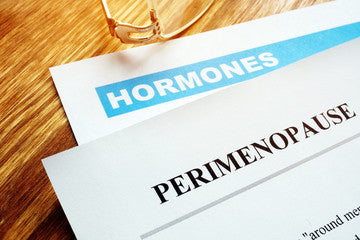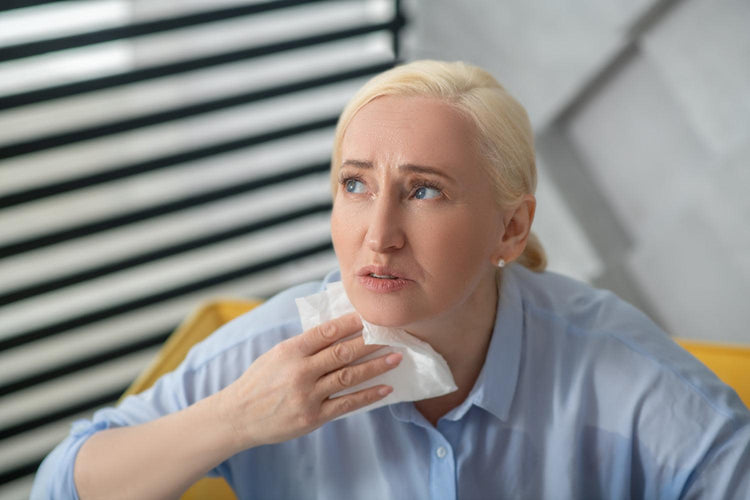
 Instagram
Instagram
Signs Perimenopause Is Ending and What Comes Next

Related products
The years leading up to menopause in women's lives are known as the perimenopause. This transitional period, which usually begins around the age of 40 but may even begin earlier in one's mid-thirties, is characterised by shifts with declining oestrogen and progesterone levels causing physiological changes to occur gradually.
Numerous biological cues indicate that the perimenopausal stage is giving way to the menopausal stage as specific key indicators become more noticeable. Two symptoms include the reduction in strong hot flashes that last for a year or longer after the commencement of postmenopause, and the irregularity in menstrual periods that gradually become less frequent until they stop entirely.
In a noteworthy study conducted by The Study of Women's Health Across the Nation (SWAN), it was shown that 95% of the participants had alterations in their menstrual cycles prior to going through a year without menstruation, which is a clinically recognised indicator of approaching menopause.
Hormone fluctuations can cause discomfort such as mood swings and difficulty falling asleep because of night sweats, which makes it difficult to get a good night's sleep. Cognitive problems, such as memory problems, can occur. Body changes that are evident include dry skin, thinning hair, and weight gain around the waist.
When women enter the full menopause phase of their life, many of the previous symptoms still exist but get better over time. However, when the female hormones' protective shield against cardiovascular disorders wanes throughout perimenopause, the risk of health problems grows. In the early years after menopause, this sensitivity may cause heart-related issues to become noticeably apparent.
Any woman entering the phase after menopause must actively participate in maintaining her health by making regular appointments with medical professionals and adopting healthy habits that support both physical fitness and mental strength. This is especially important in light of the factors to consider regarding the potential outcomes of such a situation.
What is perimenopause?
During perimenopause—the stage before menopause—women experience changes as their reproductive hormones like estrogen and progesterone decrease. This phase usually begins in the 40s. Can start as early as the mid 30s for some women. Symptoms like periods and hormonal changes such as hot flashes and mood swings become noticeable during this time.
As women age and enter menopause the ovaries decrease oestrogen and progesterone production which are essential, for menstruation and fertility purposes leading to menstrual cycles until they cease completely signifying the beginning of postmenopause.
Symptoms during menopause can vary widely among women. From inconveniences like night sweats and hot flashes to more serious issues like intense mood swings or even depression. Showcasing the diverse ways in which each woman navigates this significant stage of life due to unique hormonal. Showcasing the diverse ways in which each woman navigates this significant stage of life due to unique hormonal reactions.
When Does Perimenopause Start?
Perimenopause often begins in the 40s for women, but it can also start in the mid-thirties for others.
The ovaries gradually generate less oestrogen and progesterone throughout the menopause, a normal period of ageing that is crucial for menstruation and fertility. Every woman experiences this phase at a different time, based on her genetic makeup and outside variables like smoking that could have an early beginning.
The hormones involved in this process begin to act at the beginning, creating changes in menstrual cycles. These changes can include periods that are longer or shorter, heavier or lighter, or stop completely, signalling the start of menopause. These alterations are marked by signs such as hot flashes and night sweats which are indicative of the physiological changes occurring within a woman's body.
Another notable distinction is the duration, which varies from one to approximately ten years. This timeline variability adds an element of unpredictability to the process of transitioning to postmenopausal life, but there are specific indicators that can help identify this phase of change and allow people to adjust their lifestyle and prepare appropriately for a more seamless transition into postmenopausal life.
Signs Perimenopause is Ending
More Frequent Hot Flashes
Hot flashes during the perimenopause are frequently brought on by oestrogen levels affecting the body's capacity to control heat from the brain's temperature-regulating hypothalamus. A person has an increase in the frequency and intensity of hot flashes as the perimenopause phase comes to an end. This is because hormone imbalances impact the thermoregulation process, causing abrupt heated sensations, perspiration, and palpitations.
These kinds of episodes typically last for ten minutes or so. range in severity from mild to severe discomfort that seriously interferes with daily activities. However, when they grow more frequent, they indicate the impending menopause. Though initially difficult, these symptoms usually gradually go away as menopause progresses, facilitating the body's easy adjustment to hormonal balances.
Reduced Libido
Many women may experience a decrease in their desire for sexual activity during the perimenopause. Hormone imbalances are frequently to blame for this, which can result in decreased libido as well as physical pain from decreased lubrication, such as dryness and irritation in the vagina. These elements have the potential to drastically lessen excitement for new things. In essence, the balance of hormones like progesterone, oestrogen, and testosterone determines a woman's sex drive. Any hormonal imbalance may have consequences, which explains why a discernible decline in libido may signal the approach of the last menstrual cycle.
Having to deal with erratic symptoms can be emotionally taxing. Make the deterioration more apparent and emphasise that, in order to improve health and well-being, physical and psychological components must be addressed jointly rather than separately.
Changes In Sexual Functioning
As the perimenopause ends, symptoms of altered sexual functioning begin to manifest. These modifications show up as less strong orgasms and a longer duration for arousal. It demonstrates the impact hormones play in various facets of sexuality. The reproductive system is a sensitive organ that is affected by changing hormone levels. Hormone production by the ovaries affects all aspects of reproduction, including the pleasure derived from intimate encounters, and leaves a marked legacy.
Moreover, pain and dry vagina might result in further barriers that hinder the creation of the ideal setting for fulfilling sexual experiences. This is a sign of moving on to the next phase of life, which is marked by unique changes that influence decisions in this particular way.
Vaginal Dryness
Dryness is sometimes a symptom that the menopause is about to start. Lower levels of oestrogen have an impact on the vaginal lining during the perimenopause phase, which is the time before menopause. The lining needs oestrogen to remain thick and elastic and to lubricate itself in preparation for sexual activity. The vagina may get thinner and less lubricated as menopause approaches, which can cause friction during intercourse that can cause pain and discomfort.
Beyond sexual interactions, the drying effect can also cause generalised non-sexual discomfort, such as a minor burning feeling or a constant need to urinate, in addition to urinary tract infections or elevated inflammation. All of which point to the impending end of the reproductive phase and offer insightful information about the changes,

This is a list of remedies for vaginal dryness and lubricants that can help with it, such as Durex Play Feel Lubricant and Sylk Personal Lubricant.
Anecdotal Changes (Fewer Headaches, More Stable Moods)
According to accounts, there have been reported improvements such as fewer headaches and more stable mood patterns. These indications are consistent with the theory that the primary cause of the body's fluctuating hormone levels is what causes the severity of symptoms to vary. The underlying cause of post-menopausal symptoms like a noticeable drop in headache frequency starts to show signs of abatement as the body returns to normal with decreasing hormone levels. erratic hormone levels. Gain greater equilibrium.
In a way, mood swings also function. Because our hormones are a shared foundation that affects everything fundamentally, the fluctuating emotions we often experience are linked to changes in our hormones over time as they shift and settle down towards a more balanced state. This also influences our unpredictable mood shifts and shows how interconnected different aspects of women's lives are.
Symptoms Of Perimenopause
Indicators of the perimenopause include irregular cycles, hot flushes, nocturnal sweats, disturbed sleep due to these sweats, and mood swings.
The body experiences physical symptoms as the menopause approaches because of fluctuations in hormone levels, particularly a reduction in the ovaries' synthesis of progesterone and oestrogen. The biological patterns of a woman are upset by these changes.
Variations in menstrual periods are one typical indicator. Before completely stopping when menopause takes hold, periods might start to become erratic and fluctuate from month to month.During this time, hot flashes—a sensation of heat spreading across the upper body or entire body—are also common. They might be accompanied by flushed skin or heavy sweating, which can cause frequent awakenings from night sweats that can seriously impair sleep quality.
Emotions can range from mild irritability to severe emotional anguish that occasionally resembles clinical depression during this phase of influence on brain chemistry.
Other discomforts include decreased sexual desire, which is frequently connected to lowering testosterone levels, and dryness that causes painful sex (dyspareunia). an important component of female desire. are also rather widespread, however less evident than the previously described indicators; they have a more intimate yet comparable effect on general health.
How Do I Know I'm in Menopause?

When a woman has not had her menstrual cycle for a year or longer, her condition is diagnosed as menopause. This indicates that her progesterone and oestrogen levels are dropping, which means she will no longer be able to reproduce.
A variety of symptoms can affect women during the perimenopause. Such as periods that are occasionally particularly light or heavy and that abruptly alter the duration of their cycles, either completely missing or spaced farther apart. resulting in fluctuations that finally stop completely as a signal of entering the more permanent postmenopausal period.
Hot flashes are another typical symptom. Heatwaves that radiate to the upper body's areas and are frequently accompanied by a rapid heartbeat can also result in facial flushing and perspiration. Additionally, during the night, nocturnal sweats might happen. These can seriously disturb sleep patterns and make you feel exhausted or irritable the next day.
Among the symptoms are dryness brought on by a discernible decrease in lubrication, which is medically known as dyspareunia and can be uncomfortable during sexual activity. In addition, some women suffer with urge incontinence, a condition in which an intense sudden urge to urinate can occasionally result in unintentional leaking episodes, or recurrent infections (cystitis).
Regarding health concerns pertaining to women's health during the perimenopause, in particular, which are marked by memory loss and depression symptoms associated with hormonal fluctuations that impact mental and emotional capacities momentarily until hormone levels level off at lower thresholds, restoring stability over time without having an impact on later life stages.
Despite the justification that cites a year without a period as a benchmark for women's health, each woman experiences changes in her own way. Maintaining communication with healthcare providers is essential in order to recognise warning indicators for improved treatment in later life and throughout transitional periods, as well as to greatly improve general well-being.
Menopause Stages

When a woman's monthly cycle ends, she goes through a transition known as menopause, which consists of three main phases: perimenopause, menopause, and postmenopause.
The first stage of perimenopause is marked by a change in the body's hormone production when oestrogen levels fall and hormone balance is upset. This leads to a variety of symptoms, including irregular periods and hot flashes. usually beginning in one's mid-40s. Some people start seeing symptoms in their 30s, and this transition lasts until menopause is officially recognised.
Menopause is the term used to describe a woman's natural ability to become childless after she misses her period for a full year.It suggests that problems with the ovaries' ability to produce the progesterone and oestrogen hormones that regulate fertility.
The years following menopause are referred to as postmenopause, and during this time, many symptoms persist even though they tend to lessen in intensity. However, during this time, people are more susceptible to heart-related problems, particularly in the early stages of the postmenopausal period, because they have less protection against cardiovascular diseases from female hormones prior to menopause. The higher risk of osteoporosis due to the decline in oestrogen levels is also a major issue because it reduces bone density and increases the chance of fractures in the future.
This big shift has several phases, each with distinctive characteristics that highlight particular qualities exclusive to that phase. It is evident that there is no one pattern for these changes since it is associated with a variety of physical discomforts and mental alterations that can differ significantly from woman to woman. Thus, every experience is distinct and individual, with every woman meeting her particular set of obstacles head-on.
For a better knowledge of menopause, its symptoms, and the supplements you might want to utilise, check out these further articles on the subject.
Summary
Menopause, which marks the end of menstrual periods, is an important milestone in the female reproductive timeline. The three primary phases of this trip are the menopause, post-menopause, and perimenopause. Hormonal changes during perimenopause, which is frequently seen as the start of menopause, result in irregular periods and physical problems including hot flashes because of lowered oestrogen levels. After twelve months without a period, menopause officially begins. This marks the end of fertility as the ovaries become less active in releasing the hormones needed for reproduction. Menopause is followed by the post-menopausal years, during which time any residual symptoms gradually disappear. However, because pre-menopausal hormone protection declines, there is a tendency for heart disease and osteoporosis risks to rise.
Frequently Asked Questions
What is the final stage of perimenopause?
The final phase of perimenopause concludes when menstrual cycles cease completely over twelve continuous months (this period essentially confirms the onset) which signifies entering menopause.
What comes after perimenopause?
Once perimenopause wraps up (and this transition ends), it leads into menopause—signifying an end to natural fertility since ovaries reduce their production of necessary female hormones required for regular menstruation or reproductive capabilities.
When do perimenopause symptoms stop?
Perimenopausal symptoms don't have a precise endpoint; they usually continue through menopausal years but often lessen in intensity as one enters full menopause.
What are the symptoms of your period ending?
Signs pointing towards an ending period include increasingly erratic menstrual patterns until they stop altogether (accompanied by other physical issues like intense hot flashes or night sweats among others), indicating rising hormonal imbalances during these transitional phases.
What is the next stage after perimenopause?
After finishing perimenopause comes 'menopause', identified by twelve uninterrupted months without menstruation which marks the conclusion of a woman's childbearing phase (thus starting her post-reproductive life).
How do you know Menopause is ending?
Recognizing when menopause concludes involves keeping track of ongoing symptoms such as hot flashes which peak early on but tend to diminish over time (though they may persist less intensely beyond ten years from last periods). Additionally there's withdrawal from some health protections previously offered during pre-menopausal stages against cardiovascular problems leading to heightened risk especially within the first few postmenopausal years.




















 Rated Excellent by 26,523+ Reviews
Rated Excellent by 26,523+ Reviews